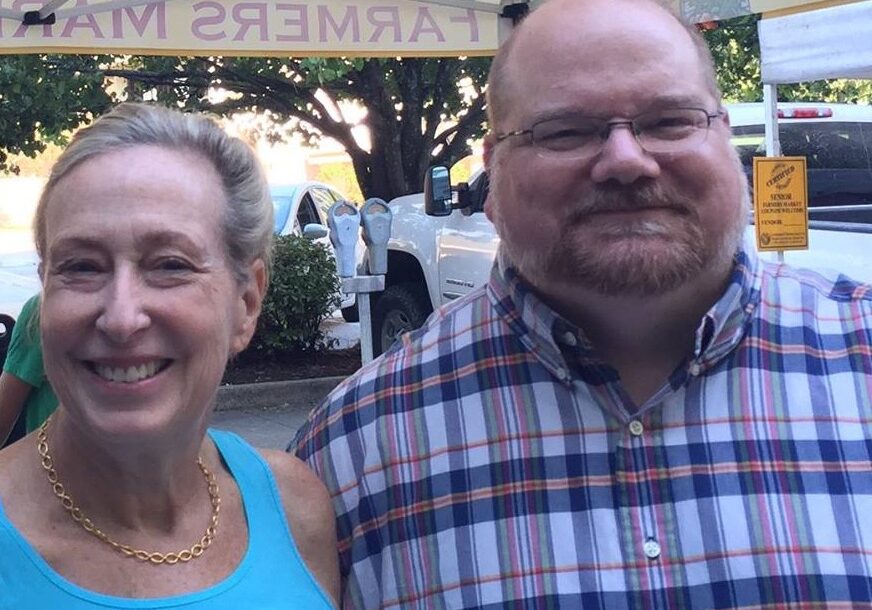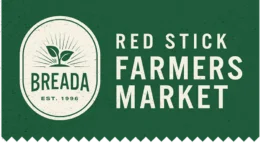A Look Back from our Co-Founders

We recently caught up with Chris Campany and Susan Turner, co-founders of BREADA & Red Stick Farmers Market, to give a brief history of BREADA and a look back about the market’s early days.
Chris Campany:
What was the main goal or vision when you began the planning process?
Through an urban design studio taught by Susan Turner we learned of many desires and needs of historic South Baton Rouge. As a class we had the opportunity to engage directly with the community. Two of the issues that kept coming up were the lack of a supermarket in the neighborhood and the lack of fresh food, and the prevalence of vacant lots being created through the demolition of houses through Operation Takedown. In our talking to people in the neighborhood I met Matthew Byrd who sold greens from the back of his truck on a corner. That planted the idea of having producers sell what they grew for the benefit of the neighborhood (the freshest possible food), and for the producers (direct to consumer sales). I also met Willie Mae Williams, a woman with profound hope and pride for South Baton Rouge, who wanted to create a garden on a lot near her home. At the same time, the Crescent City Farmers Market and Parkway Partners community gardens project were underway in New Orleans. I toured the gardens in New Orleans and began to volunteer each Saturday morning at the market there, and brought the idea of community gardens, market gardening, and farmers markets back to the class. It was developed into a proposal for the community and it was very well-received when presented to the community. From there a coalition was built of a wide array of community leaders – including those from South Baton Rouge, the Downtown Development District, LSU, Southern University, Mid-City Redevelopment Alliance, and so many others! – to form a non-profit to execute the concept. With incredible support from the Baton Rouge Area Foundation and advocacy by Mary Ann Sternberg BREADA was born with the fiscal agent support of the Hilltop Arboretum. From my perspective it was the ultimate sustainable agriculture and community project. It was grounded in the land and neighborhoods, and its goal was to literally build community from the roots, up.
What was the biggest challenge in starting Red Stick Farmers Market? Did you realize what it would take?
Farmers’ markets that were organized around producer-only sales – that the only products being sold were those produced by those doing the selling – was a relatively new concept at the time. The national farmers’ market renaissance was just getting underway. There weren’t many farmers growing for direct-to-consumer sales at the time, so we were going to open a market before producers really had a chance to grow for one. Making the market happen required a lot of outreach with support from both LSU and Southern Cooperative Extension. We had to explain to farmers the intent of a market that would maximize the returns to them through direct marketing, and why they should be hopeful that enough people would show up and buy to make it worth their while to spend a day selling what they produce. The second major hurdle was finding a good location. We explored numerous sites and landed on the municipal parking lot in downtown Baton Rouge with the strong support of Davis Rhorer and the Downtown Development District. I’ll be candid that there were concerns that some areas of town were considered to be black or white neighborhoods. Downtown was viewed as neither – and at the time was generally vacant during weekends. It was also close to the South Baton Rouge neighborhood we wanted to serve. We had access to a bathroom, could retreat to the municipal parking garage in the rain, and had water to make Community Coffee (by me, a guy who didn’t drink coffee). It took a lot of work and a lot of patient people sitting through slide presentations, but people had faith. I often joke it was a faith-based initiative but it truly was – faith in the concept and in one another.
What was the first market day like?
Terrifying! We didn’t know if the producers who said they would show up, would, or what they would have to sell. And we didn’t know if any customers would come. We learned very quickly that customers wanted the opportunity to buy directly from local producers, so the fear pivoted from will people show up to will there be enough for them to buy.
When did you know it was all going to work out? Was there an aha moment?
The second market, really. Word of the success of the first market day spread, and more farmers came to the second market. And more customers came, too. We opened the market in November which is really an in between growing season, but the food editors at The Advocate were helpful in letting us explain what was going to be at the market each week and why. Later John Folse allowed us to do the same on his radio show. But I remember telling folk at the end of that second market that I could die a happy man. Doing this work was a dream of mine, and it had come to be.
What is your reflection of the market over the years?
I am so happy and proud that the community has continued to support the market and its evolution over all of these years. Many markets – and non-profits for that matter – last only a matter of years. It’s hard to conceive that this is the 25th anniversary of the market and BREADA. Producer markets are fragile things. They are grounded in relationships among the managers, the farmers, and the consumers. So much can go wrong, and I know that during my time and after I left that things haven’t always been easy, but folk have hung together.
How has the general landscape of food systems changed over the last 25 years?
BREADA and the Red Stick Farmers’ Market were really among the organizations and markets on the leading edge of local food. Valuing local food is almost taken for granted now. Where farmer’s markets and other direct-to-consumer market opportunities continue to shine is the relationship that forms when the consumer buys directly from the producer. In the overall marketplace that direct relationship is rare, and its why I feel farmers’ markets are critical to community well-being. They tie people to one another, they tie a community to the seasons, and they keep producers on the land.
How do you see the future of farmers markets/local food systems?
I think they’re critical. Here in Vermont when there were some shortages in food supplies prompted by the pandemic we could turn to our local producers for staples. Climate change is prompting major changes in the regions that produce much of the food that is available on supermarket shelves. I think we’re beginning to realize how fragile the industrial food system really is. Farmers’ markets and local food systems not only provide food. They also support and preserve local food-production know-how. Yes they are a source of delicious local food, but I hope consumers also appreciate their value in keeping producers on the land and providing those producers with a living wage income. They’re too often taken for granted, but they are foundational to community well-being and resilience.
What do you think people need to know about BREADA’s work?
It needs their support. It needs financial support to build and maintain the capacity to keep its work going. Markets don’t just happen. They take a lot of time and effort to maintain the relationships between and among producers and consumers, and they have to evolve and adapt to the times. They have to adapt to weather, events, changes in what’s produced and how, changes in the lives of the producers and the consumers, and even changes in the international, national and regional food system. BREADA and the market remain at their foundation a community development project.
Susan Turner:
What does local food/a vibrant local food system mean for your everyday life?
Eating is one of the joys of my life, and an important way that we connect with family and friends. Once I visited Europe, I realized that the rest of the world ate in a much more healthy and seasonally-in-tune way. I was determined to help Baton Rouge enable its population access to fresh produce which was what most of our ancestors lived on out of necessity. We have let the processed food industry destroy our community’s health, and we have to wake up before it’s too late. Support local restaurants that buy their produce, meat and seafood directly from the producers at Red Stick Farmers Market.
What is your favorite market memory?
Former BR Mayor Kip Holden was a regular market shopper downtown. One Saturday morning, a thief drove off with the milk producers’ truck full of product. The mayor saw it happen, jumped on the truck, and saved the day. Another great memory was when Dickie Brennan offered to help BREADA’s farmers recover from Katrina by coming to BR with his three chefs and serving an amazing multi-course gourmet meal at a country horse farm setting as a fundraiser.
Why do you support BREADA?
BREADA is my family’s number one priority for philanthropic support. Over its 25-year existence, it has become a community institution, and yet most shoppers at Red Stick Farmers Market do not realize that these markets only happen because of this organization which is a non-profit with no permanent funding stream. All of the sales at the market go directly to the farmers, and without those shoppers making a personal contribution to BREADA, the markets will not be able to continue. If you shop at the market, PLEASE consider contributing to BREADA, so that the markets can survive.
